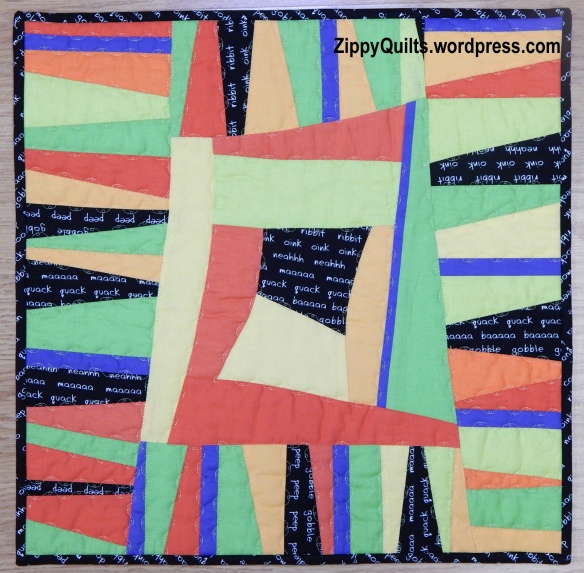Many of my scrap quilts are inspired by other quilters. I still find it useful to start with a collection of fabrics I think “go together”. In that regard, I do NOT worry about color per se, though I recognize that color is a big “bugaboo” for many quilters. I do find it useful to decide at the outset whether the quilt is to be bright or muted colors, but beyond that I don’t worry much. And of course I break that rule sometimes, too.
One of my first inspired-by-others adventures was a series of quilts I made after reading Gwen Marston’s books. I just love her aesthetic, and wish I had been able to take a class with her while she was alive. Here is a quilt I made for the Quilt Alliance annual contest a few years ago, based on Gwen’s published quilts:

“Gwen Visits the Farm” is a quilt I made for the Quilt Alliance contest; the black fabric has words representing animal sounds such as “quack”
I also used a collection of Cherrywood scraps to make this quilt based on Gwen’s “liberated log cabin” idea:

Cherrywood Toss, 59″ x 61″, 2016. My favorite part of this was making the background out of a mixture of dark colors.
Also, taking a cue from my friend who makes a small art quilt each week, I made these 3 quilts based on lessons in one of Gwen’s books:
I continue to learn from the quilters I consider “the best” by making quilts inspired by their ideas. A recent one was inspired by Maria Shell’s tutorial on improvised flying geese:

The colors of the quilt blended with the colors of my chimney, where I stuck it up to be photographed
Of course, not all such experiments are particularly successful. I love Freddy Moran’s aesthetic, but this table runner based on her ideas didn’t turn out very well, in my opinion. I expect to make more things using her ideas, and they’ll improve 🙂
Since, at this point in my quilting career, most of my fabric collection is scraps, there will be many more scrap quilts to come! Next week I’ll discuss how I use scraps in quilts made from patterns.
























